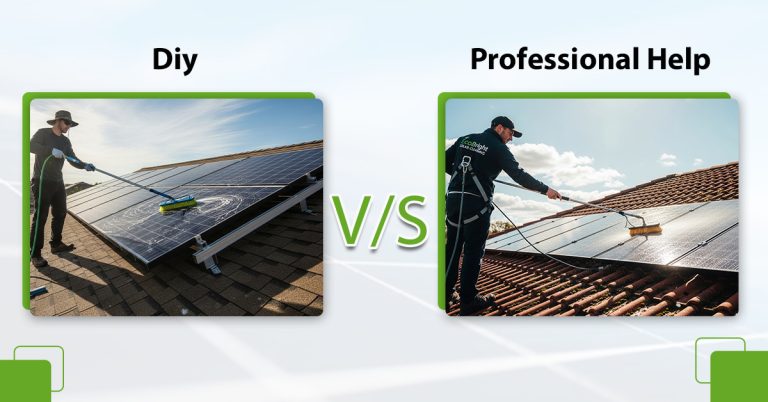Installing solar panels is a superb way to reduce your carbon footprint as well as your electricity bills. Many people are choosing them for their homes. However, solar panels come with additional overhead.
For proper functioning, it is necessary to clean them regularly. Dust buildup, bird droppings, and even snow can reduce their efficiency. Some homeowners go for DIY cleaning while others prefer professional help.
So, how do you clean solar panels using both methods? Keep reading to find out.
30-Second Summary
The question “how do you clean solar panels?” must have crossed your mind, whether you already have the system installed or you are thinking of installing it.
In this guide, learn everything about cleaning the panels using the DIY method and hiring professional cleaners. Moreover, explore troubleshooting common problems and maintenance best practices to make your solar system work at its optimal condition.
Why Solar Panel Cleaning Matters?
Soiling effect: Dirt accumulation, pollution, pollen, and bird droppings create a thin layer on your panels. According to some studies, it can reduce energy production by 2 to 5% in mild climates and 20 to 30% in arid regions.

Performance loss: Dirty panels mean less power production. A study showed 15% efficiency recovery after professionals cleaned the panels.
ROI protection: Solar system is a long-term investment. Regular maintenance means you get the full value of it.
Rain is not enough: While rain can remove loose dust, it leaves mineral streaks on the panels and cannot remove sticky residue like bird droppings.
When to Clean Solar Panels?
Cleaning the solar panels is really up to you. You may never have to clean your panels, depending on your area, solar design, and local weather conditions.
It takes a lot of dirt buildup to impact the performance of the system negatively, and a major part of the country receives enough rain throughout the year that keeps these panels clean.
That being said, if you live in an arid region with a lot of dust in the air, it is better to clean them. While cleaning, keep in mind the following.
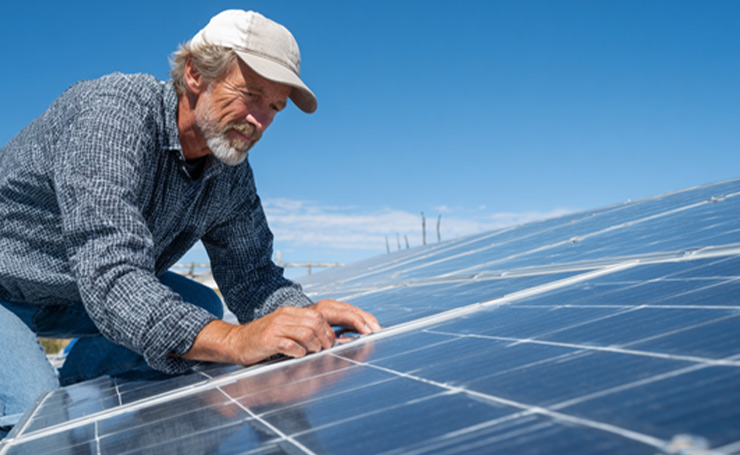
- Keep your personal safety a priority. Do not get on the roof without proper safety precautions.
- Check local weather. If there is a forecast of rain, it is better to wait and let Mother Nature handle the cleaning.
- Do not use cold water on hot panels to avoid thermal shock. Early morning cleaning or evening time is better, as the panels cool down.
- Remember, when you experience lowered energy efficiency and visible dirt on the panels, it is time to clean them.
How Often to Clean Solar Panels?
The frequency of cleaning solar panels depends on the environment you are living in. In general, you need to clean them once or twice every year. In dusty and polluted areas, this frequency increases.

- Urban areas: after every 6 to 12 months.
- Near trees or birds: more frequently due to droppings
- Desert or dry climate: 2 to 4 times a year due to sand and dust storms.
- Rainy areas: Rain helps, but streaking and moss can form.
How do you Clean Solar Panels?
For many people, the best way to clean solar panels is DIY, while others hire professionals to do so. Let’s see both methods of cleaning with their pros and cons.

DIY Solar Panel Cleaning
This is the mild soap and soft brush method.
Tools Needed
- Soft brush or sponge to clean solar panels without scratching
- Deionized water or distilled water to avoid mineral streaks.
- Mild soap or eco-friendly detergent
- Telescopic pole for rooftop access.
- Microfiber cloths for drying.
- Complete safety gear, including non-slip shoes, gloves, and a harness.
Safety First
- Shut down the system following the instructions of the manufacturer.
- Secure ladder and harness for rooftop safety.
- Do not clean in midday heat.
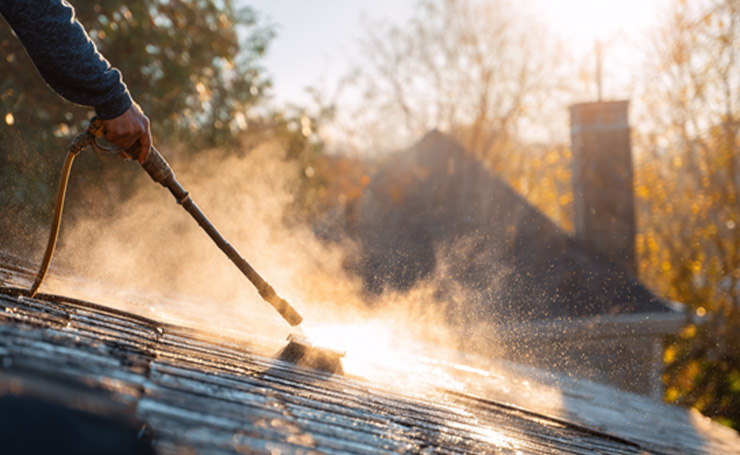
Step-by-Step Cleaning
- Use a hose with a spray nozzle to gently rinse the loose dirt.
- Fill a bucket with deionized water and mild detergent.
- After soaking the brush in the cleaning solution, start scrubbing the panels gently.
- Rinse thoroughly to remove leftover soap.
- Use a microfiber cloth to dry, as it prevents streaks.
- You can also go for a long-handle soft brush if you are cleaning from the ground and do not want to climb on the roof.
Solar Panel Cleaning Tips for DIY Success
- Clean in straight strokes instead of circular motion.
- Do not step directly on the panels.
- If you are using tap water, wipe it dry to avoid hard water streaks.
- Record the date you clean the panels for future reference.
Pros: Straightforward and cost-effective
Cons: Time-consuming, risk of leftover soap if not cleaned properly.
Professional Solar Panel Cleaning
You might need professionals, depending on the size of your house and the height of your roof. You should also hire pros after a natural disaster, a significant drop in power production, and for annual cleaning (if you live in a dusty area).
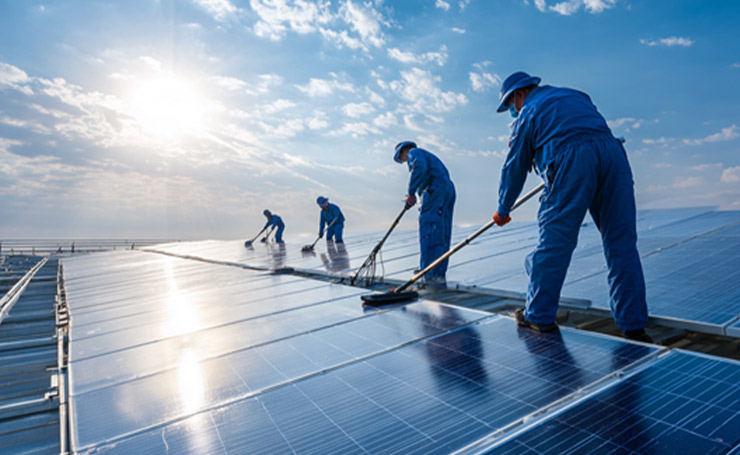
Cost Range
- For residential cleaning, the price ranges from $100 to $300 per visit.
- For commercial cleaning, the price is charged per panel or square foot under a long-term contract.
Pros
- It is safe.
- Professionals thoroughly clean.
- The process is warranty-compliant.
- The procedure is fast.
Cons
- It can be costly if done too often.
- The quality of the service depends on the provider.
How to Choose a Service
- Always ask for certifications and insurance.
- Make sure that they use non-abrasive methods.
- Look for before and after reports to compare the results.
- Check their reviews before hiring.
Advanced Cleaning Technologies
Robotic Cleaning Systems: These systems clean the solar panels autonomously. They sweep the surface with brushes and deionized water.
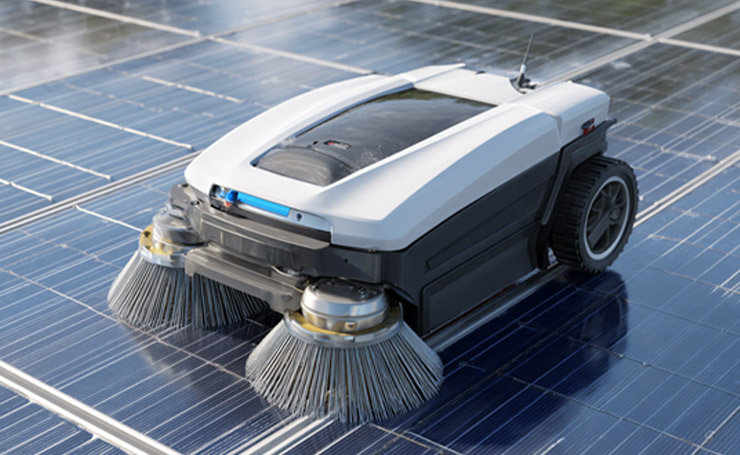
Electrostatic Cleaning: This technology removes dust and debris without water by using sonic vibrations.
Anti-Soiling Nanocoating: It is water and dust-resistant and also reduces the need for frequent cleaning.
IoT and Sensor-based Monitoring: These smart systems identify dirt accumulation and send cleaning alerts.
Troubleshooting Common Issues
Hard water streaks: Avoid them by wiping the tap water dry or using deionized water instead.
Bird droppings: Spot clean them before they harden.
Mineral deposits: Utilize a diluted mixture of vinegar and deionized water.
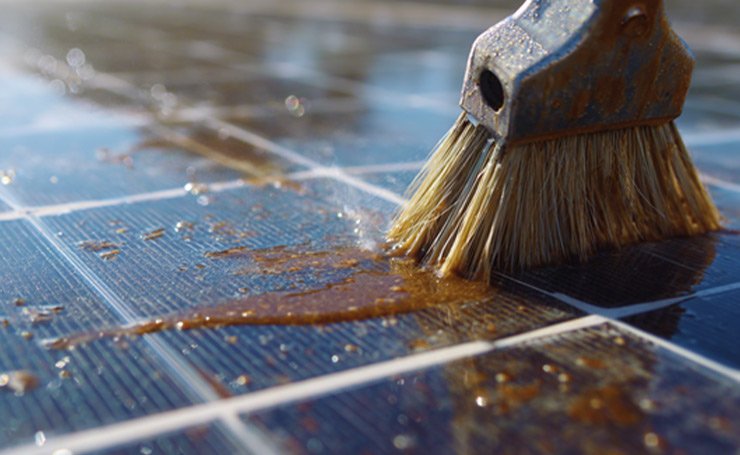
Scratches: If you see scratches, it is better to stop DIY methods and call professionals.
Algae or moss: Scrub with a soft brush gently and do not use strong chemicals.
Maintenance Schedule and Best Practices
Monthly: Usually, an inspection from ground level is enough to show you if there is dirt accumulation.

Every 6 to 12 months: Clean the panels, particularly if the climate is dusty.
After storms or heavy pollen season: A quick rinse ensures that dust does not build up in the long term.
Every 1 to 2 years: Get professional inspection and cleaning done to restore power efficiency.
Additional Tip: Track the solar inverter’s output weekly. If you see a significant dip, check for dirt buildup.
Wrapping It Up
Solar system installation is an investment that provides you with full value if you take care of it. But how do you clean solar panels for optimal power production? This guide explains it all.
Whether you opt for the DIY method or hire professionals, keeping the panels clean is necessary for the longevity of the panels.
Are you a sustainability enthusiast? Get the latest information about solar panels and more on Green Energy Insights.
FAQs
What is the Best Way to Clean Solar Panels without damaging them?
The best way is to use a soft brush or a sponge dipped in a deionized water and mild soap mixture. Avoid using harsh chemicals or abrasive materials.
Can I Clean My Solar Panels or Should I Hire Professionals?
You can clean your solar panels if they are easy to access. However, for high roofs and hard-to-reach systems, professional service is safer and more thorough.
Do Dirty Panels Actually Affect Energy Production?
Yes, solar panels with accumulated dirt can significantly reduce energy production by almost 10 to 30%, depending on the buildup.
Can I Pressure Wash my Solar Panels?
No, pressure washing can crack the glass and damage the seal. Always use low pressure while rinsing the panels.
What is the Best Time to Clean Solar Panels?
The best time is either late evening or early morning when the panels are cool to prevent streaks and thermal shock.
How do you Clean Solar Panels using a DIY method?
For DIY cleaning, use a long-handle brush with soft bristles, hose the panels gently, and always switch the system off before cleaning. Do not climb the roof without safety gear.

